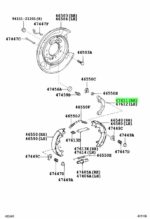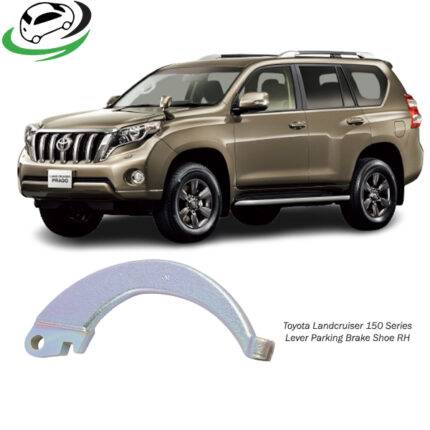-13%






Toyota Land Cruiser 150 Series Lever Parking Brake Shoes RH 47612-60020
Part No: 47612-60020
Brand: Genuine
Fits: Toyota Land Cruiser 150 Series
KShs4,000 Original price was: KShs4,000.KShs3,500Current price is: KShs3,500.
Payment Methods:
The lever parking brake shoes (right-hand side) play a crucial role in a vehicle’s braking system, especially in ensuring the functionality of the parking brake mechanism. This guide delves into the purpose, construction, benefits, installation process, maintenance, and signs of wear associated with the right-hand lever parking brake shoes.
The primary purpose of lever parking brake shoes is to create friction against the drum of the parking brake system when the parking brake lever is engaged. This action locks the rear wheels in place, preventing the vehicle from rolling when parked, especially on inclines.
The parking brake serves as an essential safety feature, ensuring that the vehicle remains stationary even when the transmission is in neutral. This is particularly important for preventing accidents or unintentional movement.
In addition to the primary hydraulic braking system, the lever parking brake serves as an auxiliary braking mechanism. It can be used in emergencies or during specific driving conditions to supplement the main brakes.
Lever parking brake shoes are typically constructed from a combination of materials designed to provide durability, heat resistance, and effective friction. Here’s a breakdown of their components:
The backing plate serves as the foundation of the brake shoe assembly. It is typically made of metal and provides structural support for the friction material.
The friction material is bonded to the backing plate and is designed to create friction against the brake drum. This material is often composed of composites or ceramics that provide excellent performance under varying conditions.
Spring clips are used to hold the parking brake shoes in place and to maintain proper alignment within the drum assembly. These clips ensure that the shoes return to their original position when the parking brake is released.
Many parking brake shoe assemblies include an adjuster mechanism that helps maintain the correct distance between the shoes and the drum. This feature ensures that the shoes engage and release smoothly, enhancing performance and wear.
Investing in high-quality lever parking brake shoes provides numerous benefits that contribute to vehicle safety and performance:
High-quality brake shoes ensure that the parking brake functions effectively, securely holding the vehicle in place. This reliability is crucial for preventing unintended rollaway, especially on sloped surfaces.
Well-constructed parking brake shoes are designed to withstand the wear and tear associated with regular use. High-quality materials resist degradation and provide a longer service life, reducing the need for frequent replacements.
By ensuring that the parking brake engages correctly, quality brake shoes contribute to overall vehicle safety. They help prevent accidents caused by vehicle movement when parked.
Properly functioning parking brake shoes enhance the overall performance of the braking system. They provide smooth engagement and release, ensuring consistent braking feel and response.
Installing lever parking brake shoes is a task that can be undertaken by those with some mechanical knowledge or performed by professional mechanics. Proper installation is essential for ensuring that the parking brake operates effectively. Here’s a general overview of the installation process:
Before beginning the installation, gather the required tools, which may include:
Before driving the vehicle, test the parking brake by engaging and releasing it several times. Ensure it locks and releases smoothly without any unusual noises.
Regular maintenance of lever parking brake shoes is crucial for ensuring optimal performance and safety. Here are some maintenance tips:
Check the condition of the parking brake shoes during routine vehicle inspections. Look for signs of wear, such as thinning of the friction material or cracks in the backing plate.
Be attentive to any unusual noises when engaging or releasing the parking brake, such as squeaking or grinding. These sounds may indicate that the shoes need replacement.
Be aware of any changes in the performance of the parking brake. If it fails to hold the vehicle securely, it may indicate that the shoes are worn or improperly installed.
If the parking brake feels loose or does not engage fully, the adjuster mechanism may need to be adjusted. Follow the manufacturer’s specifications for proper adjustment procedures.
Follow the manufacturer’s recommendations for parking brake shoe replacement intervals. If the shoes appear worn or damaged, they should be replaced promptly to ensure safety.
Understanding the signs of wear is crucial for maintaining brake safety. Here are some common indicators that the lever parking brake shoes may need replacement:
If the parking brake does not hold the vehicle securely, it may indicate that the shoes are worn and need replacement. Test the parking brake on a slight incline to assess its effectiveness.
Persistent squeaking or grinding sounds when engaging the parking brake may signal worn friction material. This condition requires immediate attention to prevent further damage.
Inspect the parking brake shoes for visible signs of wear, such as thinning friction material or cracks in the backing plate. If the friction material is worn down to the minimum thickness specified by the manufacturer, it’s time for a replacement.
If you notice any resistance or difficulty when engaging or releasing the parking brake, it may indicate that the shoes are misaligned or worn out.
If the parking brake lever travels further than usual before engaging, this may be a sign that the shoes are worn and not making adequate contact with the drum.
Lever parking brake shoes (RH) are essential components of a vehicle’s braking system, providing reliable performance and safety. By understanding their purpose, construction, benefits, and maintenance practices, vehicle owners can ensure their parking brake operates optimally. Regular inspections, timely replacements, and using high-quality parts are crucial for maintaining effective parking brake functionality and ensuring the safety of both the driver and passengers. Prioritize parking brake maintenance to enjoy a safe and smooth driving experience.
Follow us on Facebook for more parts.
You must be logged in to post a review.
No account yet?
Create an Account
TEAM ONESTOP
Typically replies within minutes
Looking for parts?
Team Onestop
Car Parts Specialists
🟢 Online
WhatsApp us
Reviews
Clear filtersThere are no reviews yet.